Hoghead's Skybird, Redbird, and Yellowbird Page



Home |
Killed Trans Am Archive |
Trans Am Parts
Hopper | Trans Am Tech Talk |
Bandits | Sky,Red,Yellowbirds |
Hoghead Store
Hoghead Garage |
Island of Misfit Trans Ams
| Hoghead's Excellent Adventures |
Ultimate Restoration |
Fun | Links



For pictures and help on this page I am indebted to Fred Schramm of Pontiacpower.net, Heiko Kraatz of www.Bandit-Trans-Am.de, David Reed, Anne and Jim Clendenny, Aero Appraisals of Bentley, Alberta, Ben Gullickson, James Bryant, John Green, Mark Wilcox, Jimmy Means of The Firebird Gallery, and the Chicago Auto Show history site.
I am still seeking information! If you own one of these cars, or just want to correspond with me about them, send email to redsky@firebirdtransamparts.com
(Off this page): |
In short, these cars are exciting for three reasons:First, they have tons of visual impact. By color coordinating a two-tone body, interior, outrageous decal package, wheels, grille, and even the taillights, using unique colors and features not available on any other Firebird, Pontiac created a flash of color that has no equal. It combines the Formula appearance package with the Trans Am Special Edition appearance package, and ads even more features of its own. If you see one of these cars on the road, it'll get your attention. I bet everybody that's seen one (or more) can remember the jolting first impression. |  |
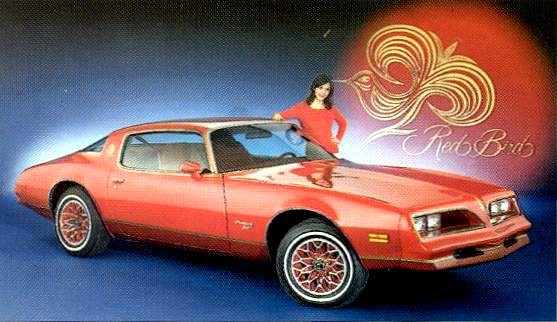 | Second, the bird decals on these cars are obviously female. Feminine. Girls. A lot of guys bought these cars too, and more own them today (including me), but it's pretty hard to argue that the decals aren't feminine. Pontiac appeared to be aiming this car specifically at lady car collectors. I really cannot say why cars are not marketed specifically for women, but this has almost never been done. As far as I know it had only been done once before, when Dodge offered the "La Femme" in 1955 and 56. The La Femme was marketed as a fashion accessory. In 1969, Chrysler Corp marketing also mentioned ladies liking the "mod top" upholstery option, but it is more of a unisex thing, really. Pontiac's marketing materials were nowhere near as direct as Dodge had been, but if you're primarily interested in Trans Ams, one of these could be a show car for your wife or a great counterpart to your Trans Am. |
| Third, the survivors are going to be very rare. Adding to my second argument above, ladies don't collect cars, and they have mostly disappeared. Some of these cars have been babied and kept in excellent condition. The rest, at some point, usually fall into the hands of a hairy-legged guy who tries to kill the appearance package. I don't think many junkers will be restored. Today, at least, you can grab a nice one for a reasonable price and show up at the car show with something that's truly different. Do you think this Yellowbird would stand out on a field full of fake 1969 Z28's? | 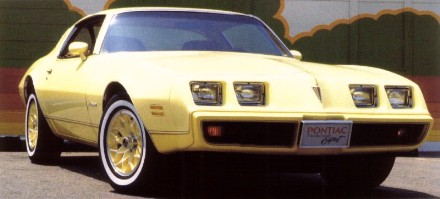 |
Features Overview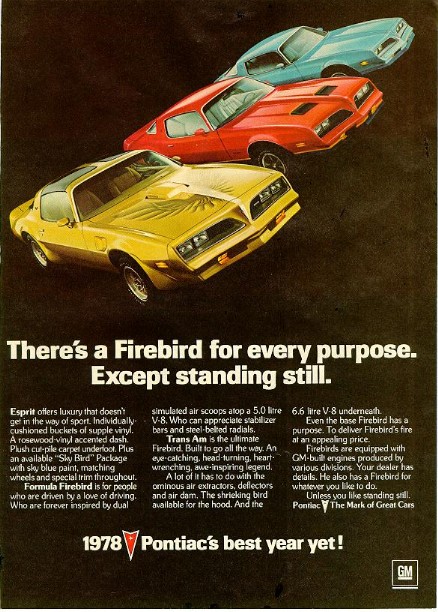 In 1977, Introduction of the Skybird gave Pontiac special appearance packages on three Firebird models: Esprit, Formula and Trans Am. The Trans Am appearance package, black with gold pinstripes, would go on to become wildly popular as a result of Smokey and the Bandit. In 1977, Introduction of the Skybird gave Pontiac special appearance packages on three Firebird models: Esprit, Formula and Trans Am. The Trans Am appearance package, black with gold pinstripes, would go on to become wildly popular as a result of Smokey and the Bandit.This 1978 advertisement at right is my favorite Firebird ad, almost showing all three packages together (the gold T/A shown is not quite a special edition). This is the only magazine ad that I have for any of the Sky/Red/Yellowbirds.
Contents of the Appearance Package:To the regular Esprit features, the Appearance Package added the following:
From this, it's obvious that this Special Appearance package was more special and had more appearance! It's like the Formula and Trans Am appearance packages added together, plus extras. |
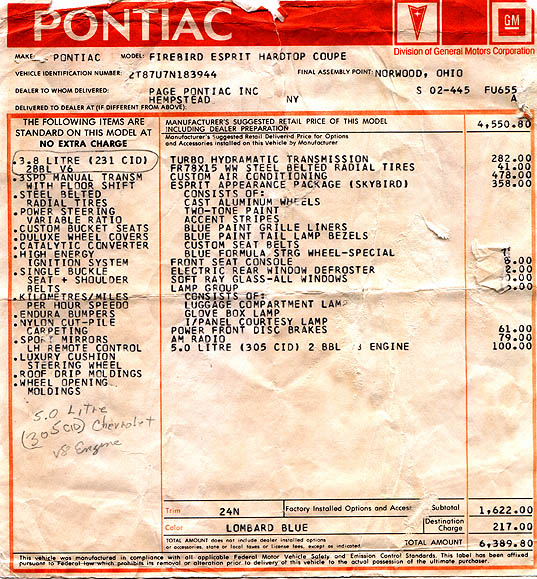 | At left, here's a window sticker from a 1977 Skybird that gives Pontiac's description: There are a few instructive things to notice about this window sticker. First, the column at left shows the standard Esprit (not Firebird) equipment. From this, you can see that the V6 3-speed was theoretically available in the 1977 Esprit (and Skybird). The Esprit had a standard V8 engine in years past, but this was gone by 1977. Second, at a price of $358, this doesn't agree with the published option lists for the price of a Skybird. From the VIN number, this car was built in April. There must have been a price increase some time during the year. Since there's no mention of Lombardy cloth, I guess this was the vinyl interior version of the Skybird package. But that's just a guess. Third, the Chevy 305 2-barrel, which had replaced the 301 2-barrel on the option list on February 1, 1977, is very typical of Skybird powerplants. The Esprit could have a V-6 or a 350, but most had the in-between 301 or 305. As long as you didn't change the color of anything, the rest of the Esprit option list was available as far as I know. Skybirds, Redbirds, and Yellowbirds are so rare, we'll probably never know if there were other option prohibitions with this package. Could you delete the Snowflakes? (Bandit Trans Am orders could and did). Were any V6 3-speed Skybirds made? We'll probably never know. One thing I have found, in the 1978 dealer manual, is vinyl tops were not available on the Skybird. By the way, it's clear the names "Sky Bird" and so on are two words on the decals. However, in some written documents (like this window sticker), GM used one word. We're sticking to one word on this page because Skybird and Yellowbird are very good internet search terms. Redbird is a word in the English language, so it's not quite so specific. |
Ladybirds History1976 - The BluebirdAll writings about these cars start with an obligatory mention of the "Blue Bird" show car, which I believe was built for the Chicago Auto show in February 1976. Apparently the car was a hit, and Pontiac decided to put the package into production. The 1977 Dealer Manual, which came out around May 1976, announced Esprit would have a "luxury appearance package" based on the Blue Bird, but no name was given. This picture at right shows the Blue Bird at the Chicago Auto Show in 1976. I had to laugh at the ashtray. Those were the days! The car's actual color isn't preserved very well in this picture. |
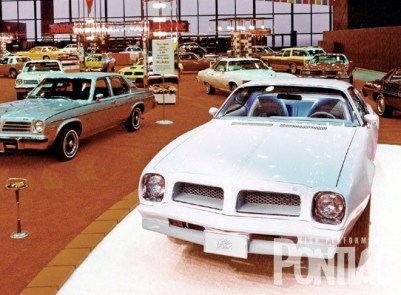 |
| According to the story, the Blue Bird Body Company (which builds school buses of the same name) had the name trademarked for automotive use, so the "Skybird" was born instead. |  A Bluebird | 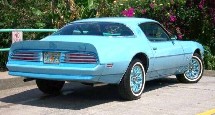 A Skybird |
| 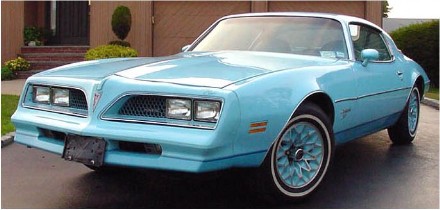 | |||
| The decals on the Skybird were also unique and a BIG departure from normal Firebird practice. These decals included royal blue double pinstripes, two-tone bird decals, "Sky Bird" scripts, and a two-tone border around the bottom accent color and tail panel. | 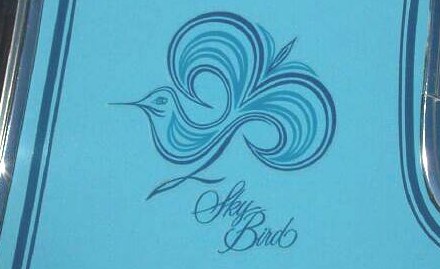 | |||
| ||||
| Two-tone layout on the Skybird was exactly the same as the Formula appearance package. The color break went through the bumper crease and the front bumper openings. The tail panel and tail light bezels were painted the accent color, with a decal looping around this area. These decals would be a difficulty in restoring a Skybird. They might never be reproduced. The wheels are Lombard Blue, as you can see, and are also coded with color 21 on the build sheet and on dealer order sheets. The center caps are regular colors with a red bird emblem. The pinstripes are similar to the layout on around the windows of a Trans Am Special Edition, except that the two stripes across the top of the roof and down the middle of the trunk are omitted. The pinstripes ring the rear window in this photo. | 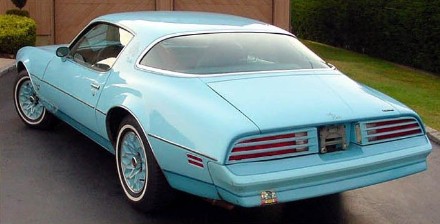 | |||
| Skybirds were available with or without a rear spoiler, and there were resulting differences in the decals. Without the spoiler, the center of the trunk has the script words "Sky Bird" and there is a chrome Pontiac plate emblem on the passenger's side. The spoiler version of the decals had a "Sky Bird" script on the right, the Bird graphic in the middle, and a light blue "Pontiac" set into the stripe on the right side. It's just like a blue Formula stripe, but the colors are different. This picture is much more true to the correct colors, and here you can really get a good look at that accent color. It think it's flat-out gorgeous. This is the biggest area of the accent color on the car. | 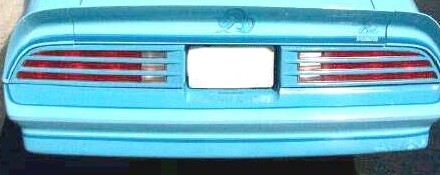 | |||
| I think this emblem was only used on Esprits without rear spoilers (maybe it was all Firebirds). If somebody knows better, please let me know. The parts books don't list the applications for this on Firebirds, but a quick scan down the part listings shows that this emblem was borrowed from the Lemans parts bin. If you have a Skybird and your "Pontiac" plate has fallen off, you'll probably have to hunt for one on a late 70's Lemans. My parts books only go to 1981, and it was used from 76 to 81 at least. | 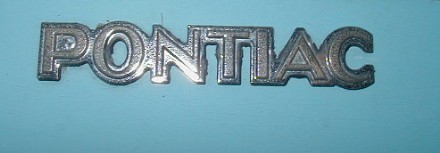 | |||
| The body color grilles are another unique feature that wasn't used on other Pontiacs. It's usually not obvious from photos, but the grilles are two-tone blue, using both Skybird colors. The mesh part of the grille appears darker, and it is. It's hard to tell in a photo whether that's just because of the dark openings. The blue/blue color line is the same as the gold/black two-tone grilles used on other models. This picture also shows the colors of the lower stripes. The upper half of the stripe matched the lower paint. | 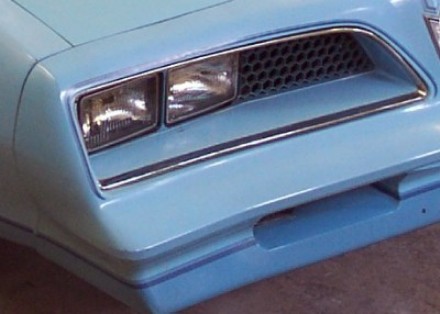 | |||
| In addition to another view of the two-tone grille, you can also see the hood stripes in this photo. After looping around the windows, the pinstripes came along the top of the door, onto the hood, then turned parallel down the middle of the hood. Since there was no shaker to interrupt them, they just went all the way to the Pontiac emblem. | 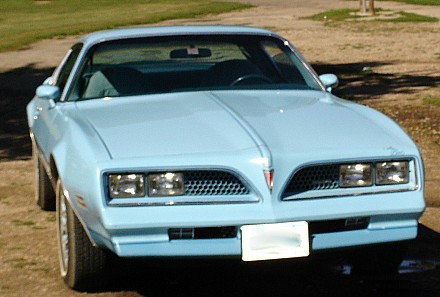 John Green Photo | |||
| The interior of the 1977 Skybird had another unique feature, a blue Formula steering wheel. At the time, all other cars with Formula wheels had to use black. 1977 Trans Ams used a black steering column and wheel no matter what the interior color. Both vinyl and velour seats were available in blue. All Pontiac interiors were two-tone in 1977 except red and black. Note the two colors in this blue scheme. The dash, steering column, console, kick panels, carpet, lower seat belt reel, and rear package shelf should be the darker color, while everything else is the lighter color. Color-coordinated seat belts, an option on every other model, were part of the Skybird package. The instrument panels in Skybirds were initially woodgrain, like this one. Later, they switched to an engine-turned aluminum dash bezel from the Trans Am. This might have been a very late mid-year change in 1977, but I have not found a bulletin stating that. | 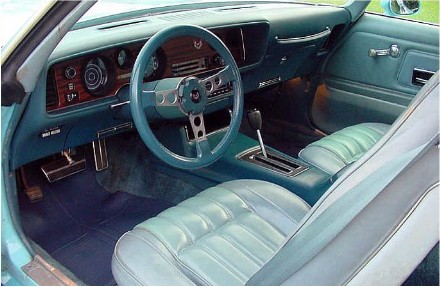 | |||
| This photo shows the velour interior, also two-tone. In this case, the car has an engine-turned dash bezel, reportedly original, which is typical of 1978 Skybirds. This is the only 77 I have ever seen with this feature. People who sent in their information have helped me bracket the date of this change to June, assuming all their instrument panels were correct and original. I have a set of parts books dated "effective June 1977" and these do show new part numbers for 3 blue-tinted aluminum Skybird bezels and switch plates, applying to years 77-78. New parts were marked by a star, and these were new part numbers. So you can draw your own conclusion of "original vs. correct" from that. Oddity File: For some strange reason, blue standard interior wasn't available on any Firebird. It wouldn't have been available on Skybirds anyway, but it's odd they didn't make it at all. All the other colors came in standard trim. | 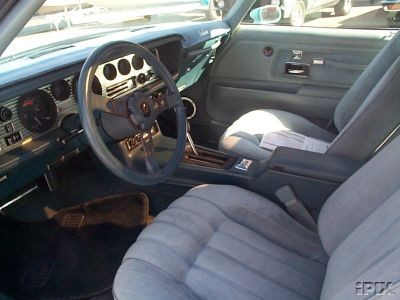 | |||
| Engine choices on the 1977 Esprit (and therefore Skybird) were initially the 3.8l Buick V6, 301 2-barrel V8 (shown at right) or the 4-barrel Pontiac 350. | 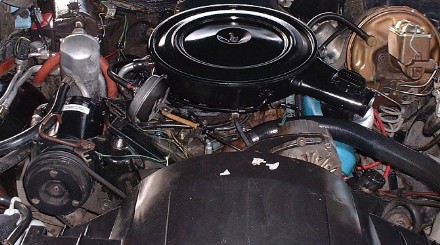 | |||
| Some 1977 Skybirds were built with Oldsmobile 350's as well (at right). References state these were used instead of the Pontiac 350 in California and in high altitude areas. These are analogous to a 403-powered Trans Am, which was had the exact same emissions-related coverage. They're uncommon, but I have seen a few of them over the years. | 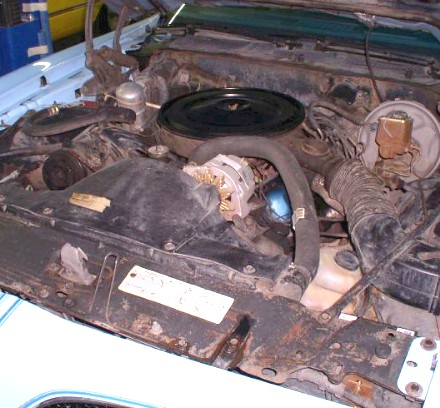 | |||
| Later in the year, (February 1, I think) the 301 was replaced by a Chevy 305 2-barrel. This is basically identical to the 78 version. One difference was the fan shroud. This photo shows a very strange-looking fan shroud, which looks like it was made by extending the shroud designed for a different powerplant. This contraption wasn't used on the 1978 cars. | 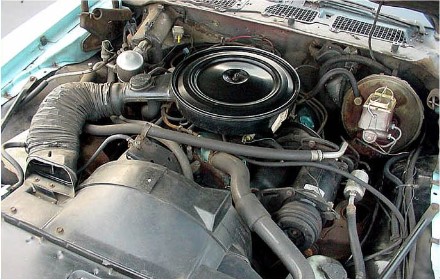 | |||
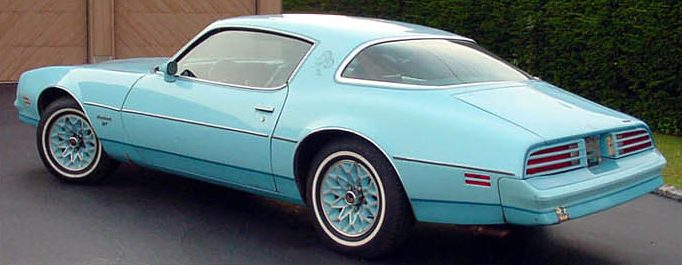
Got Skybirds?I hope you're impressed by this. With its two colors, decal package, pinstripes, dash, wheels, grille, and steering wheel, the 1977 Skybird had 8 features that weren't available on any other Firebird. The only ordinary blue item was the interior.By mid-1977, it looked like the Esprit appearance package was hitting its stride, and a second version of the package was in the works. In February, 1977, The Redbird concept car was unveiled at the Chicago Auto Show (right). Even through the Redbird had flown from the nest, Skybird production continued about one year more, until January or February 1978. | 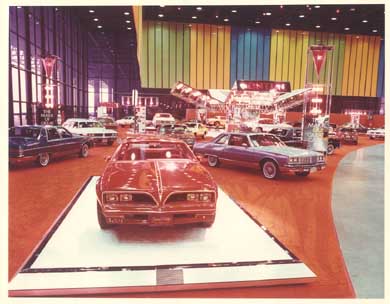 |
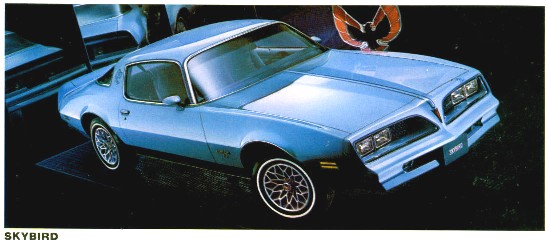 | Heading into the 2nd year of production, Pontiac was apparently pleased with the Skybird. Pontiac's 1978 brochures and promotional materials promoted the Skybird heavily. |
| 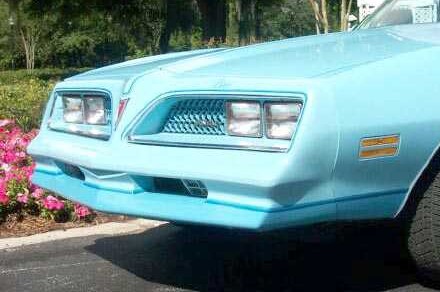 | |||
| ||||
| The 1978 product brochure (long version) devoted a whole page to Skybird photos, using them to display Firebird features on the left side. There are a few shots of the blue-tinted dash on this page. For a long while, I had no idea this was tinted, as most all of them today are faded away. If you check under a gauge ring you'll see what it originally looked like. It's just a tad greenish considering everything else on the car is a totally pure blue. Some of these photos were used to show features available on other Firebirds. The Rally II and wire wheel illustrations appear to show Lombard blue Firebirds that aren't Skybirds. I don't think there's any such thing, except in this brochure, to keep the page all one color! Note the Fisher T-tops. Pontiac planned to roll them out at the 1978 model year change, but they were delayed. We bought some salesman's fact books at the 2004 Trans Am Nationals, which state that Hurst tops were not allowed on the 1978 Skybird (they're common on the 1977). I wonder why this was done. It might be that they didn't think the Hurst tops looked good. I don't know. | 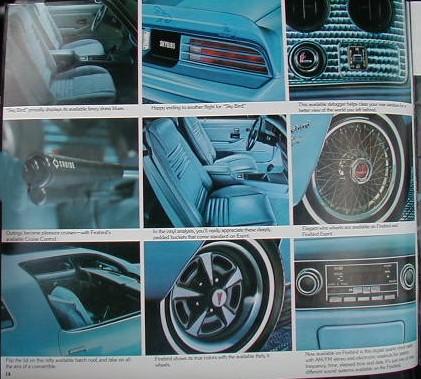 | |||
| Since the Skybirds were phased out as the Fisher tops were phased in, the number of 1978 Skybirds with t-tops has to be close to zero. A Skybird with Fisher tops would be extremely rare if any exist. Anybody have one? Send me an email if you do. So far, I've had one picture that might be a winner. Click here to see our leading candidate so far. What do you think? | ||||
The late 70's blue interior fades like crazy, so the only way to make finer points about it is with a very fine preserved example. As luck would have it, this 5,000 mile museum piece (at right) turned up on eBay a few years ago. First, this car still has its blue tinted dash, and this is the only good quality picture of such that I have. Second, this is the first good look we've had at a common Ladybird oddity. These cars had engine-turned aluminum dash bezels like a Trans Am, but often didn't have rally gauges, which required a different dash bezel, with a chicken where the volt meter should be. A bezel like this (engine-turned without gauge holes) at a swap meet is a sure sign of a Skybird, Redbird, or Yellowbird being parted out somewhere. Skybirds used a regular red dash chicken as shown here, and regular red emblems on the nose, steering wheel, and gear shift. They have no gold trim whatsoever. Third, the steering wheel is too dark to match the dash. This is entirely correct. A quick look at the parts books shows that the 1977 wheel was used again in 78 (same part number), but the 1978 interior is clearly a different color. | 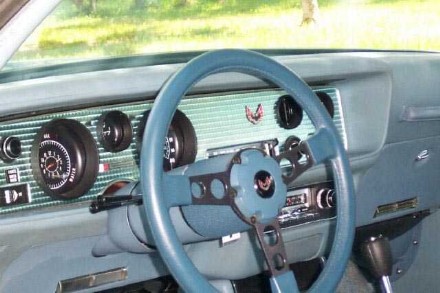 | |||
| ||||
| Engine Choices for 1978 were revised quite a bit. The Pontiac 350 was out of production, and the Olds 350 wasn't used. All references state that Pontiac 301's weren't used in 1978 Firebirds. So the available Esprit engines were the Buick 3.8l V-6, Chevy 305 2-barrel, and Chevy 350 4-barrel. This means, of course, that no Pontiac-powered Esprits or base Firebirds were made in 1978. Kinda hard to believe, but I've certainly never seen one. Almost all 1978 Esprits are Chevy V-8 powered. Chevy-powered cars are remarkable for having the air conditioner compressor on the "wrong" side, requiring extra long lines to cross over. This is a 305, but the 350 looks nearly identical. | 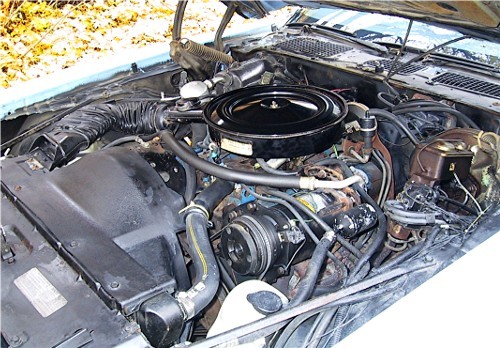 Gentry Lane Photo | |||
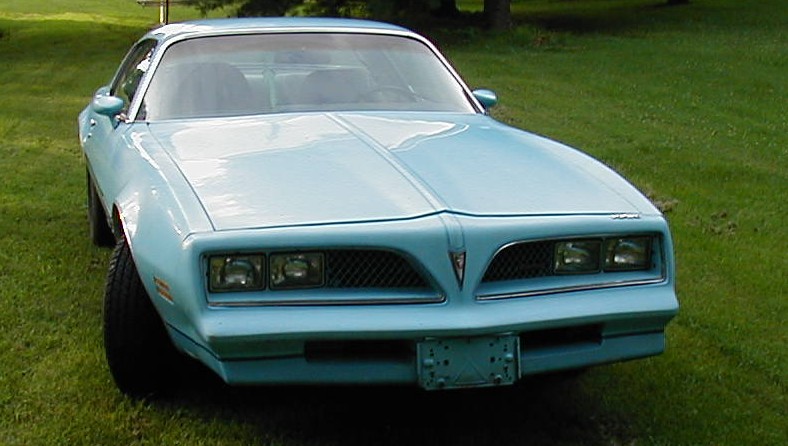
You may have seen this car listed on ebay by "Gentry Lane", a classic car dealership in Canada. They took great pictures.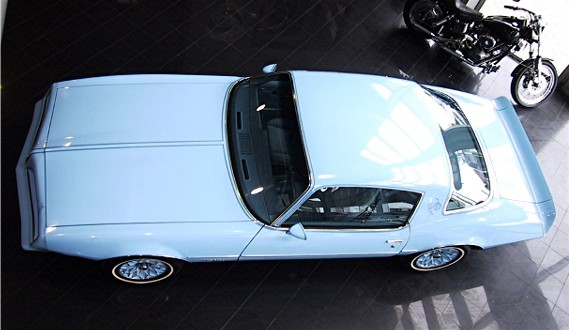 Gentry Lane Photo
Gentry Lane Photo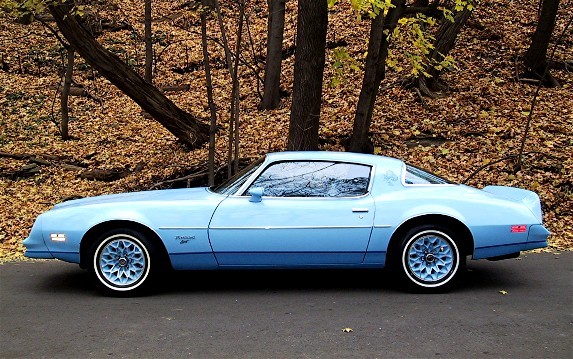 Gentry Lane Photo
Gentry Lane Photo
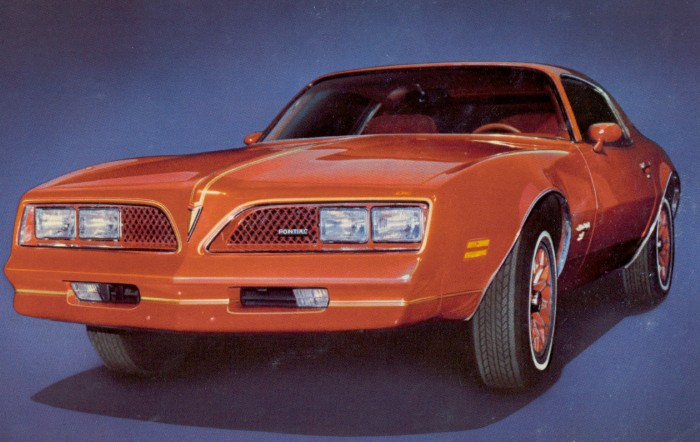
| As the Skybird had been a blinding flash of baby blue color, the change to the Redbird was jarring. The paint scheme on Redbirds was flashy, far more masculine, and somehow, avoided clashing with itself. The gold trim of the Special Edition Trans Ams was borrowed for a red, red, red, and gold theme. In my opinion, the Redbird is the prettiest of the three. Redbirds were RPO W68 and remained so through 1979. | 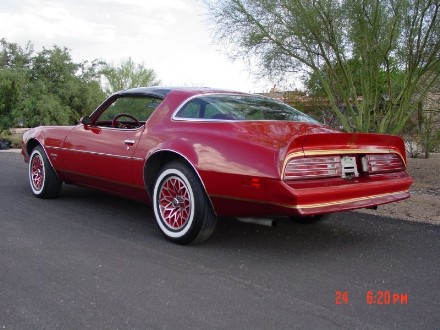 | |||
It appears then that 1978 and 79 Redbirds do not have the same upper color. | ||||
| At right is a 1979 Redbird cowl tag. This is a Van Nuys, California tag, and the Norwood, Ohio tag looks a little different. The interior color is 74B (vinyl would be 74N), and the paint is 75U and 75L (for upper and lower). On a Norwood car, the accent color might be stamped followed by M like 80M (or 42M on a 78). The date code is 01A, telling us the car was made the first week of January (1979). "A" means the first week, and "01" means January. A 78 Trim Tag would be similar but stamped with paint code 72. | 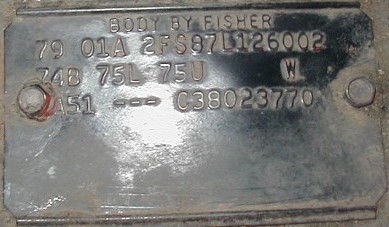 | |||
|
Amazingly, there was a widely published photo of the Redbird prototype. I have no idea who found and scanned this, but I received it from Fred Schramm at Pontiacpower.net. This GM photo shows styling prototypes for the Kammback, Gold Edition and Redbird. This photo appeared on the cover of Motor Trend. The Redbird, which is probably the same one that appeared at the 1977 Chicago auto show, looks like it's Roman Red. It's obvious this is an official design department photo, and all three cars are prototypes. You can tell the "Gold Edition" has 1977 interior. Both have Hurst Hatches, and the Redbird even has Red-Framed Hurst Hatches. Seen any of those lately? I didn't think so. I would be very shocked if any Redbird was actually made with this feature. If you have any information on this photo please let me know. Does that Redbird have redline tires on it? It looks like there's something there, but it might just be my imagination. | 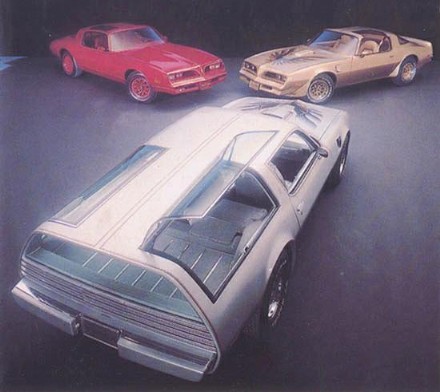 | |||
| Redbirds used gold pinstriping and the gold arrowhead of the 1978 Trans Am Special Edition. The location of stripes was identical to the Skybird. With the advent of the red grilles, the parts books began to list five colors of 1978 Firebird Grilles. Silver, Black, Gold, Lombard Blue, and (I think) Roman Red.
In most photos (not this one), the 78 Redbird grilles appear dark. Are they two-tone, like a Skybird, or all dark? Or neither? That's our latest question. Check out the grilles on the car below. Looks dark! I wish I could look at all these cars in person. | 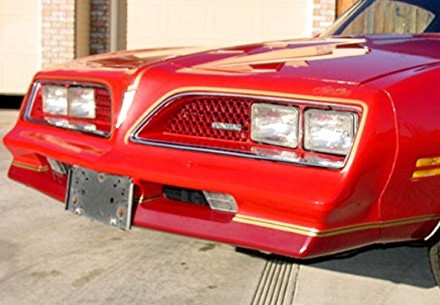 | |||
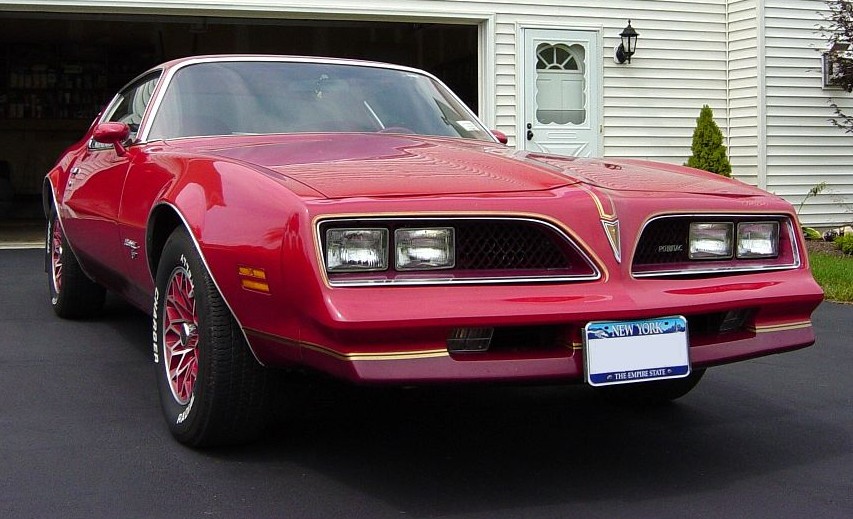 Mark Wilcox Photo The grilles in this car could be two-tone, or all Redbird Red. I can't tell. This is such a great photo, isn't it? I miss the whitewalls, though. | ||||
| Redbird interior is Carmine red with gold accents. Unlike the blue, this interior is supposed to all be one color. The application of gold items is the same as a Trans Am Special Edition. The steering wheel spokes, dash bezel, and all bird emblems were gold. Like the Skybird, the Redbird used a unique steering wheel color. But now it had a special spoke color to go with it. In my opinion, this is the prettiest Formula wheel of all. As far as I can tell, from the beginning of production, all Redbirds received the special gold interior appointments of Bandit Trans Ams. With the Gold Edition also in production, there were now two special editions using a color-coordinated steering wheel, both with gold spokes. However, tan seat belts still cost extra on the Gold Edition Trans Am. Not the Redbird. | 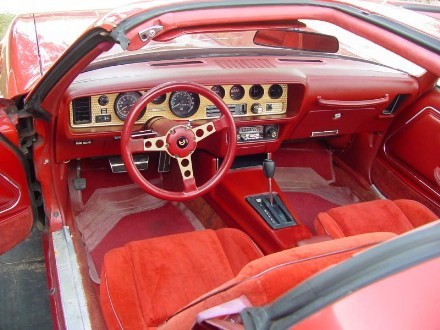 | |||
| Vinyl interior was also available. As you may have noticed by now, Fisher t-tops are downright common on Redbirds. This is a big change from the 78 Skybirds, which never (or, if one turns up, almost never) have t-tops. | 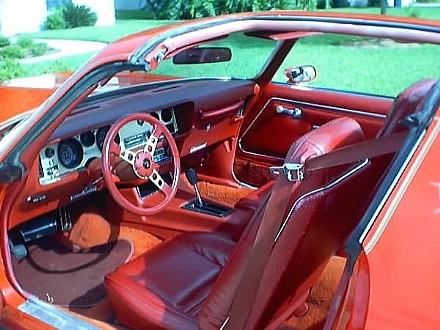 | |||
| The exterior striping on Redbirds was again a combination of a lower band of color exactly the same size and shape as a Formula, and upper gold pinstriping similar to a Special Edition Trans Am. This stripe is a little different from a Skybird or a Formula. It has two wide gold stripes, with #80 Redbird Red in the middle. This is good, because if you have to paint your Redbird, it would be fairly easy to duplicate just by using two gold stripes with paint showing between. This is a 1979, and I put it here because it's the only good picture I have of the lower color separator stripe. Look at the color of this car (Mayan Red) compared to the car below. |  David Reed photo | |||
| The decal package on Redbirds had the same bird as the Skybird, and the same style writing and decal placement. One difference is that the decals were no longer two-tone. Where the Skybird incorporated the accent color into the decals, the Redbird used one gold color. Another difference is that "Red Bird" is all on one line, where the word "Sky" had been above the word "Bird". This car sure looks Roman Red. | 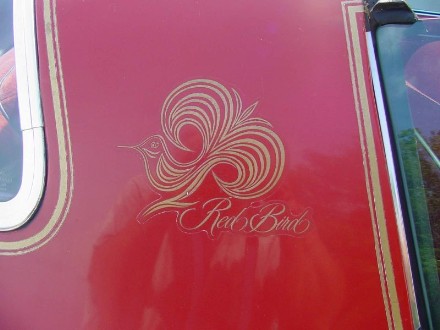 | |||
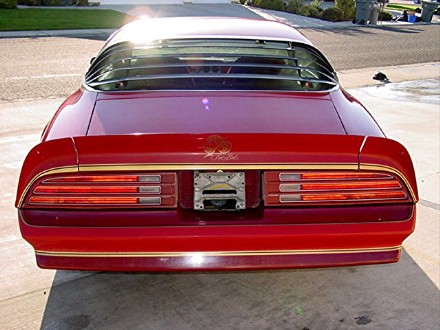 | 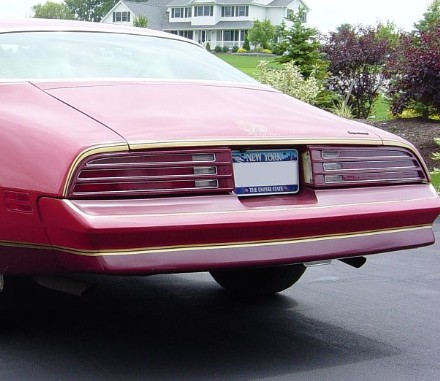 Mark Wilcox Photo | |||
| Like the Skybird, you could get your Redbird with or without a rear spoiler. Notice that the tail striping on the Redbird doesn't have the complexity of the Skybird. The overlaid "Pontiac" is gone, and the two versions of tail ornamentation have been cut to one. Whether you had a spoiler or not, you just need another sail panel decal in the middle. Even so, the fattening of the gold stripes on the spoiler end pieces would be pretty hard to duplicate on a restored car. These stripes will almost certainly never be reproduced. | ||||
| I haven't found a document stating what color the different snowflake wheels really were, (the parts book just calls them "red") but I think they should be body colored. This is a 1978 example. If anybody can find really good documentation of snowflake paint codes, please let me know!
Red snowflakes had been color coded 75P back in 1977 when they came out (Not on Redbirds, just as an option on red cars). My 1979 Redbird build sheets also have 75P for red snowflakes, so I think they're Mayan Red on my car. This means they had to switched to 72 in 1978. In the parts books, 1977 and 1979 red snowflakes are 10010053. 1978 Red Snowflakes are different, 10006758. So that's pretty good evidence that they switched from 75 to 72 and back to 75.
It's surprisingly hard to look at Snowflakes and see if they match the car or not. As I commented on the Bandit page, they seem to fade dark. I suspect it's the clearcoat that darkens them. Note the red wheel emblems. Because of all the gold trim on Redbirds, you'd think the wheel emblems would be gold too, but the red is correct. On my Redbird build sheets, the wheel center caps are coded RF. By comparing to 1978 Gold Edition Trans Ams and regular Trans Ams, it appears that RF is the regular red center cap, while RS was the special gold bird center cap. | 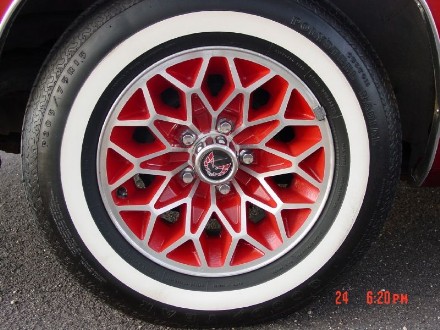 | |||
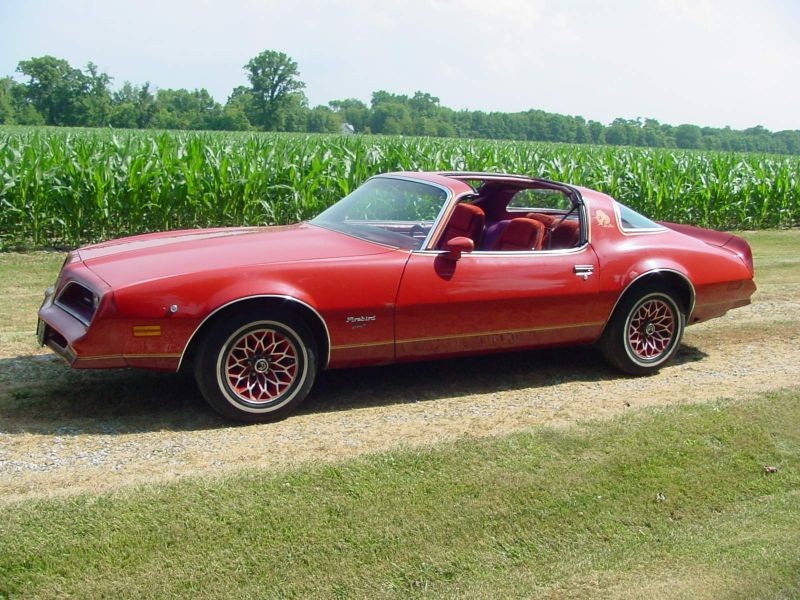
| The 1979 Firebird exterior was heavily redesigned, and this impacted the Redbird's features quite a bit. The bad news was the grilles were demoted to part of the bumper, so the color-coordinated grilles were gone forever. The good news was the Redbird was borrowing the Special Edition's gold-accented grilles. Another piece of good news was the new nose and tail had a natural color separation line built in. The accent color kicked up to take advantage of this, leaving the whole bumper the accent color. 1979 Formulas are the same way.
Another piece of bad news, depending on your taste, is that the 1979 Redbirds were an "ordinary" color, Mayan Red. This had been a Trans Am color for several years, having been called "Buccaneer Red" during the fabled Super Duty era, and is very popular with collectors. Redbirds are the only cars in the series to be painted an ordinary color, if you can consider Buccaneer Red ordinary. If the 78's were Roman Red, then the Redbirds also are the only cars in the series to undergo an exterior color change. | 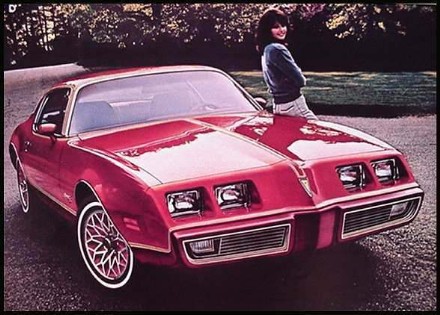 | |||
| Out back, the new taillights didn't leave anything on the back to paint, so the contrasting tail panel area was gone too. The taillights were entirely ordinary 1979 Firebird units, which were, you guessed it, red. It's hard to come up with a red-accented taillight, so they didn't.
There wasn't any good news on this end, but the Yellowbird would eventually make the big new taillights one of its best features. The spoilers were all redesigned in 1979, with the result that the 1979 Redbird's spoiler stripe is different from a 1978. These stripes appear to be a constant width, without the "fattening" on the spoiler ends that the 1978 Redbird had. If you compare the two spoilers (right and a page up left), you'll see that the 1978 stripe accentuated the shape of the 1978 spoiler itself, and wouldn't have looked right on this spoiler. | 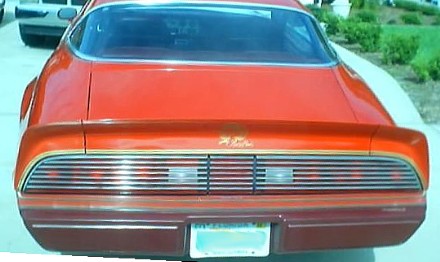 | |||
| Another piece of good news was Pontiac power was back in almost all the base Firebirds, including Redbirds. The low and high priced V8's for 1979 would both be Pontiac 301's. That's what most 1979 Redbirds have. This 301 with Canadian emissions (right) lacks A.I.R.
1979 Engine choices were kind of interesting in that the Chevy 305 was used in California, and the 4-barrel Chevy 350 was used for high altitude only. If you have a 350 powered 1979 Redbird that would be a rare car indeed, and quite a bit more powerful than the 301's. Also, for the first time, the Redbird's engine choices overlapped the Trans Am (a little). The top Esprit engine, a 301 4-barrel, was available on the Trans Am as a delete option. Over 13,000 1979 Trans Ams were built that way. | 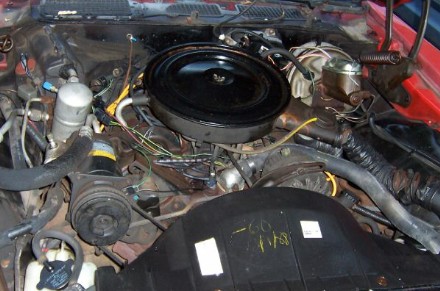 James Bryant photo | |||
| In my search for a Redbird, I found several 1979 V-6 models. I don't really know that more 1979 Redbirds were made with V-6, but I've certainly seen more myself. Here's an example. That looooong fan shroud fills up the space vacated by those two cylinders that Buick sawed off.
While we're on the subject of how many were made, 79 Redbirds are the only full year where we know the production numbers for sure. In his book "Firebird Decoding Guide" (aka "Number Crunching"), Thomas DeMauro wrote that 4,248 1979 Redbirds were made. That's out of 30,853 Esprits built in 1979. | 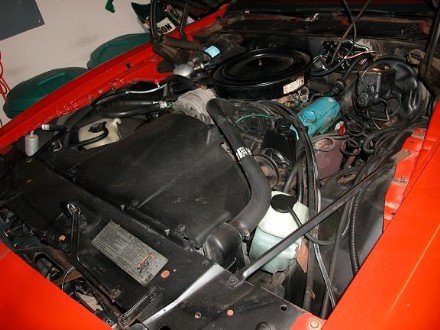 David Reed Photo | |||
| This 1979 brochure art gives a bird's eye view of the Redbird, showing the pinstripes surrounding all 4 windows and running down the hood to the arrowhead emblem. This looks about the same on any year Sky, Red, or Yellowbird. | 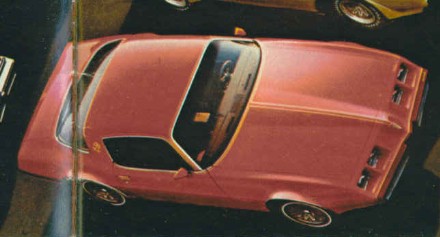 | |||
| The 1979 Firebird interiors were just like 1978, with the exception that the velour seats now came with something Pontiac called "Hobnail" cloth on the seating surfaces. Once again, you could pick vinyl if the hobnail makes you see spots. I really like it, and my Redbird has it, but it adds another restoration challenge. It's not something you can pick off a chart at an upholstery shop, and the only good solution is to use high-priced NOS material (if there's any left). | 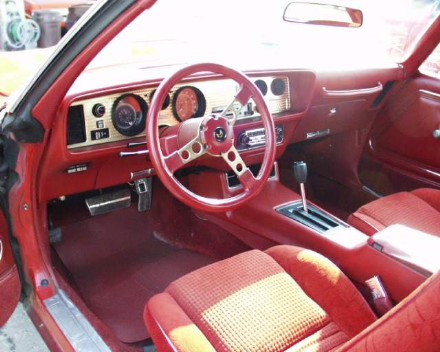 | |||
| ||||
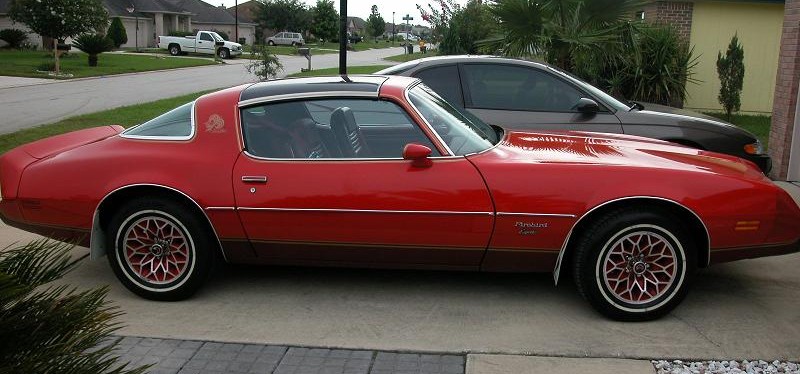
I have placed more technical information, including part numbers, striping diagrams, interior and exterior paint formulations, and build sheets on the Yellowbird Resource PageQuestions that need answering - Now with Answers!
More to come!If you own one of these cars, or just want to correspond with me about them, send email to redsky@firebirdtransamparts.com | |||||||||||||||||||||